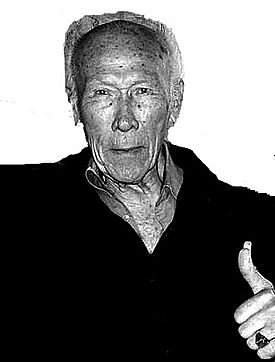Paatje Phefferkorn facts for kids
Quick facts for kids
Verdi Phefferkorn von Offenbach
|
|
|---|---|

Paatje Phefferkorn, Pencak Silat champion.
|
|
| Born | 26 February 1922 Bandung, Dutch East Indies |
| Died | 1 January 2021 (aged 98) Apeldoorn, Netherlands |
| Occupation | Martial Artist |
| Nationality | Dutch |
Verdi Phefferkorn von Offenbach (born February 26, 1922 – died January 1, 2021) was better known as Paatje Phefferkorn. He was an Indo martial artist from the Netherlands. He taught Pencak Silat, an Indonesian martial art. Paatje helped make Pencak Silat very popular in the Netherlands and Europe. He also created the special flag and symbol for the Indo community.
Contents
The Story of Paatje Phefferkorn
Early Life and Training
Paatje Phefferkorn was born in 1922 in Bandung, which was then called the Dutch East Indies. When he was 10 years old, in 1931, he started learning Pencak Silat. This is a traditional Indonesian martial art.
He trained with a teacher named Mr. Sumanto. Paatje was a very talented student. He was the only Indo student at the Javanese Pencak Silat school. For seven years, he trained every single day.
Surviving War and Revolution
When World War II started in 1942, Paatje joined the air force. He worked as a mechanic and air gunner. But the planes he worked on were old. On March 8, 1942, he became a POW of the Japanese army.
Paatje managed to escape the prison camp. He went to the Preanger mountains and joined other fighters. They fought against the Japanese in a guerilla war. Even though he was half Indonesian, his blue eyes made him stand out. He was caught again by the Japanese military police.
Most of the other fighters did not survive being prisoners. Paatje barely made it. After Japan lost the war, he weighed only 21 kilograms (about 46 pounds).
After the war, there was a lot of trouble in Indonesia. This time was called the Bersiap period. Paatje was stuck in a prison camp. He was frustrated that Japanese guards had to protect him. So, he stole weapons and escaped again.
He survived this difficult time. He tried to build a home for his family. But things were very chaotic during the Indonesian Revolution. Eventually, Paatje and his family moved to the Netherlands.
Bringing Silat to Europe
Paatje arrived in the Netherlands with no money. He had seven children. He kept practicing Pencak Silat for himself. In 1967, he opened a small school in Utrecht.
Soon, he opened a second school. In the end, he ran 17 Pencak Silat schools across the Netherlands. He became an important advisor for the Dutch Pencak Silat union. In 2013, he was honored in the National Dutch Hall of Fame for Martial Artists.
Paatje Phefferkorn passed away on January 1, 2021. He was 98 years old. He died from problems related to COVID-19.
The Indo Melati Flag
Paatje Phefferkorn also created the 'Indo Melati' flag and symbol. This flag shows pride and loyalty for the Indo community. It also stands for peace and non-violence.
Here is what the symbols on the flag mean:
- The two tilted 'siku-siku' (tridents) and the 'golok' (sword) show that Indo people are advocates and fighters. They stand up for what is right.
- The 'kembang melati' (jasmine flower) is in the middle of the triangle. This flower means charm and beauty. It especially represents Indo women.
- The star on top means brightness in dark times. It shows people who shine when things are tough.
- A 'padi' halm (young rice stalk) surrounds the symbol on both sides. This means good fortune and prosperity.
- At the bottom, the word INDO is written in gold capital letters.

